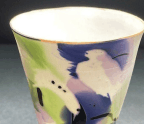Photos/Pots and Pots/Photos Ceramics and Photography: Similarities and differences
It is generally acknowledged that sculpture and ceramics have much in common. I have argued elsewhere that actually, beyond three-dimensionality, sculpture and ceramics have very little in common, possibly even nothing at all. In fact, I will argue here that there are more similarities (and some differences) between photography and ceramics than exist between ceramics and all and any other art form. Among the differences, the most obvious is that ceramics is one of the oldest of the arts while photography, and its descendants, the youngest. This being said, ceramics is the most multi-disciplinary of the arts and as such shares commonalities with all of them. The multi-disciplinary aspect is an integral part of its specificity in its bringing together of form and surface, 2D and 3D, image and object; ceramics interfaces with all and any art forms in significant ways, including architecture.
This is particularly true in its relationship with photography; a relationship that has largely been ignored.
The argument I am making here for such deep connections and relationships between ceramics and photography will be developed following this framework:
1. Both imply an alchemic transformation, based on chemical and physical processes.
2. Both use light, ceramics as radiating heat, contained in the kiln, photography as captured light.
3. Both are forms of archives, of memories and experiences.
4. Both are art of time, of fleetingness and permanency.
5. Both imply negative/positive transfers and multiples, using molds and prints.
6. Both imply the parallax distortion of space.
7. Both use framing and pictorial spaces strategically.
8. Both imply differences of viewpoints.
9. Both depend on dark on light/light on dark dynamics.
10. Both are in a specific relation to death.
This list alone would suffice to establish the similarities (and differences) between ceramics and photography even though there may be other points to add. These connections and relationships may not be obvious at first and my argument is probably in many ways surprising. Yet, I will develop each one here in attempting to establish its validity and in the process provide for a deeper understanding and appreciation of both ceramics and of photography.
Anyway, death and ceramics are intimately connected in such ritualistic offerings, a connection that continues presently in their displays in museums, which are (as has been repeated numerous times before) not only temples but cemeteries for art. 92—
1. Both are based on transformational chemical and physical processes, using mechanical means
In order to realize either a photograph or an object in ceramics, mechanical means are often necessary: a camera for one and the wheel, for the other. Both are still the most common tools for the process specific to each to take place. The wheel, of course, was first used in history to make clay vessels before it was ever used for transportation, and this for nearly 1000 years, an important precedence rarely acknowledged in the history of ceramics and in its contribution to culture and civilization. Shadows creating images on the walls of caves lit with torches could also be said to have been the first cameras. Beyond mechanical means, physical transformation is also at the center of, to use a photographic terminology. This material transformation is irreversible and the same can be said of photography, since the captured image cannot be released and returned to its source either. With photography, this physical transformation is mostly chemical in nature, when light affects the specific properties of certain compounds to change under certain conditions and retain that change after exposure to the properties of other chemical compounds. In both cases, for ceramics and for traditional photography, water is an essential component of the process as well.
You’re reading a preview, subscribe to read more.
Start your free 30 days

